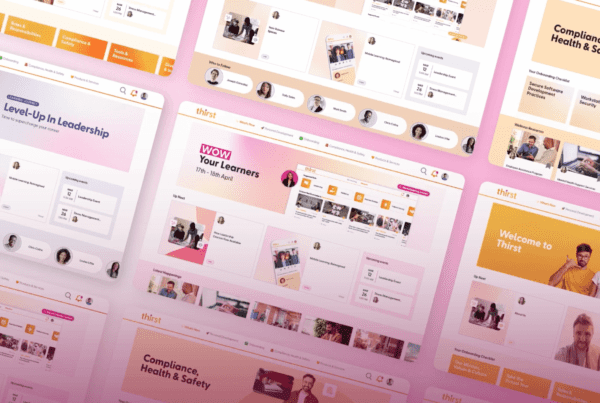As an L&D professional, you will have encountered the terms upskilling and reskilling many times before.
💭 But is your organisation adopting a culture that truly prioritises a skills-based workforce? 💭
Following the cultural shifts forced upon many businesses in the wake of the global pandemic and the rapid rise of machine learning and automation, over time, organisations that actively invest in their learning culture will reap the most benefits compared to those that don’t.
So whether you’ve been tasked with creating an upskilling and reskilling programme, or are simply curious to learn more, keep reading as we look into the key benefits of upskilling and reskilling and why this is the future of work in 2023 and beyond. 🚀
What is an upskilling and reskilling programme?
An upskilling and reskilling programme refers to an organisation’s dedicated internal recruitment plan or internal mobility.
And whilst both upskilling and reskilling are centred around learning new skills, the context of each is slightly different, as we will explain below.👇
- Upskilling is about helping employees learn the skills that will allow them to progress in their current 📈
- Reskilling is about helping employees to learn the skills that will allow them to move into a new 🪜
💡If you’re interested in diving deeper into the differences between upskilling and reskilling when you’re finished reading here, we recommend checking out our previous article: What is the difference between reskilling and upskilling why is it vital to do it? 💡
Now that you have the definitions of upskilling and reskilling in mind, you may wonder why it is necessary to act fast in adopting a culture that promotes skill-building through these mediums.
The simple answer is that the workplace is changing significantly. 🔮
What is driving the shift towards a skill-building approach?
In the workplace, cultural and societal shifts have pushed more businesses to take a skills-based approach to improve and build upon their existing workforce.
A more employee-centric, skills-based organisation ensures employees are hired and retained through their skills regardless of their qualifications or previously held titles.
This helps strengthen employee retention and engagement whilst reducing the costs associated with sourcing, hiring and onboarding new staff.
A recent LinkedIn survey found that…
- Employees who feel their skills are not being used in their current job are ten times more likely to be looking for a new job than those who think their skills are being put to good use.
- 80% of L&D professionals in the UK agree that it’s less expensive to reskill a current employee than to hire a new one.
- 57% of L&D professionals in the UK also agree that internal mobility has become a higher priority at their organisation since the COVID-19 pandemic.
Moreover, the tech landscape is also changing rapidly, contributing to a more skills-based culture. 🤖
The World Economic Forum predicts: “By 2025, 85 million jobs may be displaced by a shift in the division of labour between humans and machines. But even more jobs – 97 million – may emerge that are more adapted to the new division of labour between humans, machines and algorithms”.
✅ Businesses willing to be reactive and proactive regarding the above will thrive. ✅
So what are the benefits of upskilling and reskilling programmes?
In summary…
Through a skills-based approach, companies can attract a broader talent pool to create a workforce that promotes knowledge sharing and assists workers by advancing their careers internally.
Both reskilling and upskilling programmes also offer many other benefits, including…
Benefit 1: Employee retention
As we previously mentioned, habits and ways of working have shifted significantly since 2020 alone.
Upskilling and reskilling staff enables you to retain your best employees.
And here’s why that’s a win for you. 🏆
- Current employees know your company’s culture, products or services, history and clients.
- You will retain your best employees, who would be hard to replace.
- Your outlay for the recruitment of new staff is significantly lower.
- You don’t need to spend time and money on training new staff.
Benefit 2: Improved employee morale
Employees who are given the opportunity to upskill or reskill are more likely to feel valued and recognised within their role. 🙋♀️
Through a skills-based approach, companies can attract a broader talent pool to create a workforce that promotes knowledge sharing and assists workers by advancing their careers internally.
Not only does this boost morale in general, but it also enables other employees to see that your business is a place where staff are nurtured and invested in.
Which leads to…
Benefit 3: Improved company performance
When your employees feel valued and are more motivated and skilled, you will likely see a knock-on effect towards efficiency, output and profitability. 💰
A more skilled, knowledgeable and motivated workforce will lead to improved performance and, by extension, larger revenues and profit margins.
Which leads to…
Benefit 4: Improved company reputation 🏅
If you strive to be a leading employer that people genuinely want to work for, upskilling and reskilling programmes are great incentives to promote.
Not only that, but current employees are likely to tell others about your organisation’s investment in them and their peers. This is especially important if you are going through a recruitment drive and hope to attract the best talent.
So now you know the benefits of a skills-based workforce, perhaps you’re wondering how to identify skill gaps in your organisation so that you can make improvements.
Common reasons for skills gaps include:
- Lack of experience.
- Inadequate training.
- Poor recruitment.
- Employee churn.
- Failures in the broader educational system.
- Change in roles or responsibilities without adequate training.
A skills gap can be identified if a particular task has been assigned to an employee who needs to gain the necessary skills to carry it out successfully.
One example of a skills gap that we use here at Thirst is the example of an employee (let’s call them Luke). Luke has been asked to complete a sophisticated spreadsheet formula on Microsoft Excel. 🤔 😬
This would ordinarily be fine; however, Luke still needs to gain experience and build up his skillset with Excel and, therefore, cannot complete the task effectively.
Not only does this negatively affect Luke’s confidence and general morale, but it also means that Luke’s line manager has to re-assign the task to somebody else or spend time training Luke to use Excel in the required way. 👎🏻
Does this sound all too familiar?
Perhaps you aren’t aware this is going on…
Here are five ways to identify a skills gap in your organisation
1. Establish a base level of expectation.
Find out the base level of knowledge that exists amongst your employees at present. You can do this by interrogating and quantifying the data in a skills platform like Thirst. Once you know where your baseline of knowledge sits, you know the gaps that need filling.
2. Examine employee turnover data.
If your organisation is experiencing a high employee churn, this could indicate several learning and development-based problems. Use the data from their exit interviews to see where common themes crop up regarding lack of training or knowledge sharing.
3. Likewise, look at performance data.
Look through formal 1-2-1s with a broad range of staff of all levels to see where performance and upskilling crop up as part of a problem statement or pain point.
4. Ask your employees outright.
Individual employees are usually acutely aware of their knowledge and skills gaps, especially if they are frustrated and unable to do their jobs. You can ask employees in several ways, from formal surveys and one-to-ones to informal methods such as joining morning catch-ups and team meetings.
💡If identifying skills gaps within your organisation has sparked your interest, you may enjoy our in-depth guide on seven ways to identify skills gaps in your workforce.💡
📣 Did you know you can close your skills and knowledge gaps with Thirst? 📣
If your business or organisation suffers from gaps in skills and knowledge, Thirst can help.
As an AI-enabled skills platform, Thirst provides skills-based learning that’s personalised and tailored to each employee.
Thirst allows your employees to create their learning pathway, selecting the skills and knowledge they want to learn and how they want to learn and offering them digestible content.
Thirst also makes life easier for L&D professionals, identifying the skills and knowledge required by employees – at the outset – before delivering the most relevant content.
Getting started with upskilling and reskilling programmes
According to data collected by LinkedIn, “Only 15% of L&D professionals in the UK say they have active upskilling and reskilling programmes, and only 5% have made it to the stage where they’re measuring and assessing results”.
Have you felt inspired to consider rolling out an upskilling and reskilling programme in your organisation?
As, after all, the future is skills.
So here’s how to do it…
🗣️ Empower your employees to vocalise and own their goals.
🫶 Identify and plug skill gaps.
🧠 Create a learning culture.
And finally, make learning accessible to all with a learning experience platform like Thirst that can help make learning enjoyable, accessible and data-driven.
Skills platforms like Thirst are designed for both upskilling and reskilling, using powerful AI algorithms to create the perfect learning content for each employee.
In fact, it’s so powerful that AI skills platforms are now widely considered the fastest way for employees to learn new knowledge and skills. 🤩
Here at Thirst, our platform is bursting with learning-accelerating features, including:
- Personalised learner journeys.
- The ability to make, manage and share videos.
- The ability for employees to share learning insights across your organisation.
- Quizzes for interactive engagement.
- The ability to upload a vast range of content.
- Real-time, data-driven reporting.
- And more!
So, if you want to reskill and/or upskill your workforce to promote skills-based culture, Thirst can definitely help.
Try Thirst today to enjoy unrestricted learning and unlimited possibilities.
For more e-learning insights, resources and information, discover the Thirst blog.
You may also enjoy:
Skills vs Competencies: What Are the Key Differences? | 7 Trends That Will Shape Learning and Development in 2023: What L&D Professionals Need to Know | 7 Ways AI Will Change the Future of L&D in 2023






